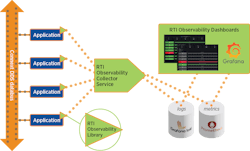Observability Framework Exposes DDS
What you’ll learn:
- Why tracking DDS data is important.
- How the RTI Observability Framework works.
The data distribution service (DDS) is an open platform standard from the Object Management Group. DDS is the communications backbone for frameworks like the Future Airborne Capability Environment (FACE) and the Robot Operating System (ROS). It can support applications that require high reliability and security, such as autonomous vehicles.
DDS uses a publish/subscribe pattern that allows for dynamic configuration, which can make tracing communication a challenge. Still, it’s very useful to know how applications communicate to find bugs and acquire information to help optimize system performance. This is where Real-Time Innovations’ (RTI) DDS Observability Framework comes into play (see figure). I talked with David Barnett, Vice President of Products and Markets, about the platform and the importance of DDS to developers (see video above).
RTI’s Connext family of DDS platforms provides a highly reliable, secure communication bus that can be plugged into applications regardless of the underlying communication network, which may span different subnets and communication protocols.
Applications can be augmented with the RTI Observability Library to communicate with the RTI Observability Collector Service. This service forwards log messages and metrics to third-party tools like Grafana Loki log aggregator and Prometheus metric system. These are typically used to track and manage diverse software environments that provide alerts and reports.
The environment is able to identify and localize problems, and subsequently address them. The framework can also be used to provide additional data to applications.
About the Author
William G. Wong
Senior Content Director - Electronic Design and Microwaves & RF
I am Editor of Electronic Design focusing on embedded, software, and systems. As Senior Content Director, I also manage Microwaves & RF and I work with a great team of editors to provide engineers, programmers, developers and technical managers with interesting and useful articles and videos on a regular basis. Check out our free newsletters to see the latest content.
You can send press releases for new products for possible coverage on the website. I am also interested in receiving contributed articles for publishing on our website. Use our template and send to me along with a signed release form.
Check out my blog, AltEmbedded on Electronic Design, as well as his latest articles on this site that are listed below.
You can visit my social media via these links:
- AltEmbedded on Electronic Design
- Bill Wong on Facebook
- @AltEmbedded on Twitter
- Bill Wong on LinkedIn
I earned a Bachelor of Electrical Engineering at the Georgia Institute of Technology and a Masters in Computer Science from Rutgers University. I still do a bit of programming using everything from C and C++ to Rust and Ada/SPARK. I do a bit of PHP programming for Drupal websites. I have posted a few Drupal modules.
I still get a hand on software and electronic hardware. Some of this can be found on our Kit Close-Up video series. You can also see me on many of our TechXchange Talk videos. I am interested in a range of projects from robotics to artificial intelligence.

